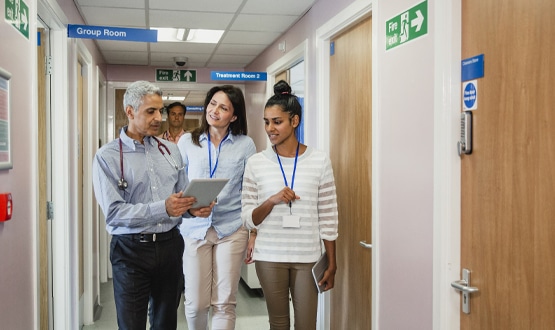Vaulting ambition
- 20 September 2012

There was a refreshingly business-like air about the launch of the personal health record developed for University Hospital Southampton NHS Foundation Trust.
As its IT director, Adrian Byrne, told eHealth Insider: “We could say it’s all about giving patients access to their records, but what exactly is the point of that?”
Instead, he said, the trust had focused on practical, business reasons for introducing My Health Record – a name it has rather cannily trade-marked – and on how it might work in the wider health economy.
The approach went down well with the audience at the city’s Harbour Lights cinema – picked as a launch venue to avoid the notorious parking at Southampton General Hospital and so the trust could show a promotional film about the project.
For example, questioners picked up on Byrne’s argument that the record might be used to deliver online follow-up to patients who had undergone simple procedures, but wanted to know who would pick up the costs and benefits of that.
Byrne said the trust needed to talk to its local GPs and clinical commissioners. “How do we get paid for keeping people out of hospital? It’s an interesting question,” he said.
“There are mechanisms like being paid for telephone appointments. We need to look at them and to create new packages to make sure that everybody wins.”
From PayPal to HealthPal
With the launch, University Hospital Southampton has become the first acute trust to build a PHR on Microsoft’s HealthVault platform.
It worked with US company Get Real Consulting on the project, following in the footsteps of South London and Maudsley NHS Foundation Trust, which launched a similar record for users of its mental health services earlier this year.
As EHI tweeted from the event, there was some surprise that Microsoft is persisting with HealthVault; the platform that it launched in the US in 2007, brought to the UK in 2010, and initially pitched at the consumer market.
But the company decided to retain the product when it moved most of its other health-related activity to a new joint venture with GE Healthcare, and Arif Govani, director of HealthVault in the UK, says Southampton will not be its last, big launch.
Indeed, the Department of Health and the Royal College of Paediatrics and Child Health are apparently planning to launch an electronic version of the “red book” child health record that is held by parents, built on the platform, in November.
Govani compared HealthVault to PayPal, the personal payments service that is now built into the websites of many online retailers and sole-traders.
“It is a citizen-owned space where people can store information,” he said. “Partners can build applications on top of that, and so create value for users.”
Supporting trust business objectives
In the promotional film, Byrne said My Health Record gave patients a “single identity” that they could use, potentially, for all their dealings with the NHS.
Other filmed speakers focused on how the service could give them a more direct relationship with hospital nurses and consultants.
Consultant Dr Mani Naghibi told viewers the new record would be particularly useful for patients in professional jobs, who might not have the “work-life balance” to spend time at their GP or “hours at the hospital.”
Instead, he said, they would be able to message their doctors and nurses directly, “bringing [them] closer to secondary care.”
In his presentation, Byrne outlined other ambitious plans for the record. He said he hoped it would enable patients to update their own demographic information and, eventually, book and manage their own appointments.
He said it should also make it easier for trust clinicians to obtain informed consent for procedures and support recruitment into research trials.
And he argued it could support electronic follow-ups to reduce demand for outpatient appointments – prompting the funding question – and support telehealth initiatives.
From Southampton to Scunthorpe
Another trust consultant, Dr Fraser Cummings, went into more detail by talking about how My Health Record could work with projects that are already underway to improve services for patients with gastric problems.
He pointed out that the conditions popularly grouped together under the label of “irritable bowel syndrome” cost the NHS some £3 billion a year to treat and can be extremely debilitating, particularly for the relatively young (16-30) population that tends to be affected by them.
He complained that at the moment there is no register of these patients, and that relatively little is known about how well they are managed, particularly in primary care.
But he said he was acutely aware that his own patients had to come into hospital for routine appointments that they did not need; while they were unable to get hold of medical staff when they did need them – in some cases leading to equally unnecessary emergency admissions.
To tackle these problems, a national IBD register is being created. And Southampton has set up a virtual clinic to provide monitoring and advice for people living with the condition; freeing up time for other work.
A survey found that all but 9.1% preferred the virtual clinic to traditional services. “I should say,” Dr Cummings joked, “that is because we have some really difficult parking problems at the General. It’s not that [me and my team] are not nice people.”
My Health Record, he said, could support these initiatives by allowing information to be shared with other local clinicians, and creating new routes for electronic communication between clinicians and patients.
“We have to start using developments like this to improve care,” he said. “For example, we have a lot of students in Southampton. Why shouldn’t they have access to information and support when they go home to Scunthorpe, or wherever?
“Health Vault puts the patient in control.” However, Dr Fraser also admitted that there was an issue about “who is going to pay for all this.”
Now for the NHS…
In his concluding remarks, Byrne reiterated that while this was an issue, there was also a big efficiency saving to be made if more of the 350,000 patients that Southampton sees every year could be dealt with electronically and, in particular, if it could “focus on the 54,000 electives.”
He also returned to his line in the film, by stressing that My Health Record could have wider application.
Returning to the PayPal analogy, he argued there was an opportunity for NHS organisations to build apps and services on it, instead of creating closed portals that would require some patients to set up many identities and accounts.
“Now, it is all about what we do as a community,” he said. “If it does not buy into this, we might all set up portals.”
For instance, he suggested that because Southampton has secured some useful URLs – such as My Health Record dot NHS and dot US – other local trusts could create their own sites on Southampton’s framework.
“They might add forward slash Portsmouth, or whatever, for individual accounts,” he said, to some laughter.
Local GP and CSS South’s clinical advisor for IT and business intelligence, Dr Amir Mehrkar, noted shrewdly that this would give Microsoft a big advantage in the emerging PHR sector.
But he also warned that with many different ways of sharing information now emerging, there was a real danger of NHS organisations creating new, online silos for patients to navigate.
“We need to assert that patients own their own information, and everything else should flow from that,” he said. “Instead, we have lots of pilots doing different things and coming up against similar barriers. We need this driven nationally.”
Supporting QIPP initiatives; sorting out commissioning; gaining first mover advantage. The issues raised by Southampton’s initiatives are new to PHR launches; but also suggest that the debate about them is maturing.



